Photo by Birgit Bekker
Namibia’s Skeleton Coast has the reputation of being one of the most treacherous coastlines in the world due to strong crosscurrents, heavy swells and dense fogs caused by the ice-cold fast-flowing Benguela Current. Even with modern equipment, the coastline still spells disaster for any vessel that gets caught up in the gale-force winds and all-enveloping sea fogs, claiming casualties as recently as 2008.
Whilst the entire Namibian coastline boasts a fascinating history of being littered with many shipwrecks, there is an assumption that these shipwrecks are easily viewed; however, the very conditions that have caused the ship to get stranded are also the reason that over time very little is left of the shipwreck. At best you may view the rusted remains of an anchor, whilst the rest of the ship is long gone. Most shipwrecks are inaccessible by road and located in restricted concessions, and it’s best to arrange flights to view certain shipwrecks, though these are still often tide and weather dependent.
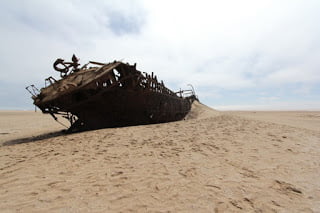 |
| Photo by Tristan Cowley |
For the best shipwreck viewing, we recommend that your guests take a scenic flight between Swakopmund and Sossusvlei, where the route flying via Conception Bay will include flying over the Shaunnee, and Namibia’s best preserved historic shipwreck, the Eduard Bohlen, a German cargo ship that ran aground in 1909 while it was on its way to Table Bay from Swakopmund. It is believed that thick fog caused the ship to founder close to Conception Bay. Years after the ship ran aground the desert began to encroach on the ocean and the ship that was once stranded in the ocean slowly became stranded in the desert. The wreck currently sits about 500 metres from the ocean, ensuring that it’s the best preserved shipwreck along Namibia’s Skeleton Coast and making it a must-see for photographers.
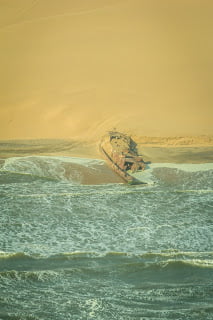 |
| Photo by Tarry Butcher |
A flight over this shipwreck is included in the Wilderness Air seat rate flying from Kulala to Swakopmund, as well as other charters and seat rates on offer on the route between Sossusvlei, the Namib Rand Nature Reserve and Swakopmund. Most of Ultimate Safaris fly-in safaris include flights over these two shipwrecks. However, it’s very much weather dependent, with early morning or late afternoon fog sometimes creating visibility problems.
Both the Shaunee and Eduard Bohlen are best viewed by air. Access by road is only as part of a 2 night/3 day camping specialized small group safari in 4×4 convoy out of Swakopmund, which focuses mostly on 4×4 driving and fishing.
EDUARD BOHLEN (1909) – best viewed by air
SHAUNEE (1976) – best viewed by air
ZEILA (2008) – viewed on beach and by air
The Zeila got stranded on 25 August 2008 in the early morning hours near “Die Walle”, a popular fishing spot about 14km south of Henties Bay. The fishing trawler that was sold as scrap metal to an Indian company by Hangana Fishing of Walvis Bay got stranded after it came loose from its towing line while on its way to Bombay, India shortly after it left Walvis Bay. It seems that they will be able to rescue no more than a few usable items from the stranded ship. Ultimate Safaris often stops here for picnics on the beach when travelling between Swakopmund and Damaraland.
Other Shipwrecks
Following are further shipwrecks located along the northern reaches of the Skeleton Coast, some which are difficult to access or where there is very little left of the actual wreck.
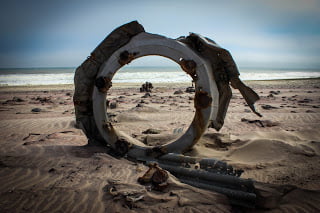 |
| Photo by Jason Nott |
DUNEDIN STAR (1942) – access limited
There are many stories about sunken ships and failed rescue attempts such as the almost unbelievable series of events related to the Dunedin Star, a British passenger liner of 13 000 tons that stranded in 1942, 40 km south of the Kunene River mouth with 106 passengers and crew members on board. They managed to take 42 people to the shore while the rest were rescued from the ship. After many fruitless and grueling attempts to reach the castaways on the beach, in the process of which another boat, the Sir Charles Elliott, two of its crew members and a bomber airplane were lost, all of the castaways were eventually rescued.
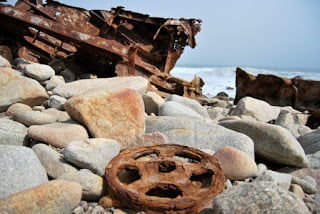 |
| Photo by Birgit Bekker |
SUIDERKUS (Dec. 1976) – possible access on day trips ex Hoanib Skeleton Coast Camp at Möwe Bay
“In December 1976 the Suiderkus, a Cape Town-based trawler, which had cost R3,5 million to build and was equipped with state-of-the-art navigation equipment, ran onto the rocks at Möwe Bay on her maiden voyage. In a few months the expensive trawler became rusted and derelict, reduced to a picturesque but temporary landmark. Battered by the waves and the passage of time, her huge bulk gradually broke apart. One stormy night her hull was deposited high on the beach. Until she disintegrates completely, she will serve the rest of her time as a cormorant’s perch and a topical subject for photographers.” (From Skeleton Coast by Amy Schoeman)
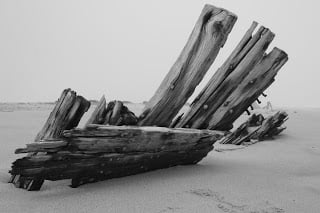 |
| Photo by Jason Nott |
S.W. SEAL
A small piece of the S.W. Seal can be seen just south of Toscanini. Nature Conservation erected a signboard north of the Ugab River, on the Torra Bay road.
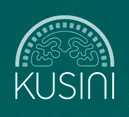



Leave A Comment
You must be logged in to post a comment.